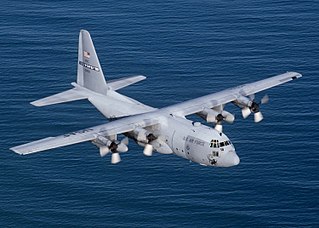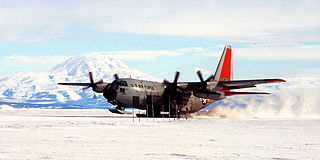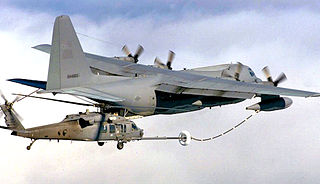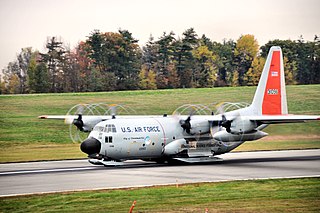
The Lockheed C-130 Hercules is an American four-engine turboprop military transport aircraft designed and built by Lockheed. Capable of using unprepared runways for takeoffs and landings, the C-130 was originally designed as a troop, medevac, and cargo transport aircraft. The versatile airframe has found uses in other roles, including as a gunship (AC-130), for airborne assault, search and rescue, scientific research support, weather reconnaissance, aerial refueling, maritime patrol, and aerial firefighting. It is now the main tactical airlifter for many military forces worldwide. More than 40 variants of the Hercules, including civilian versions marketed as the Lockheed L-100, operate in more than 60 nations.

The Lockheed Martin EC-130 series comprises several slightly different versions of the Lockheed C-130 Hercules that have been and continue to be operated by the U.S. Air Force and, until the 1990s, the U.S. Navy.

The Lockheed HC-130 is an extended-range, search and rescue (SAR)/combat search and rescue (CSAR) version of the C-130 Hercules military transport aircraft, with two different versions operated by two separate services in the U.S. armed forces.

Operation Credible Sport was a joint project of the U.S. military in the second half of 1980 to prepare for a second rescue attempt of the hostages held in Iran. The concept included using a Lockheed C-130 Hercules airlifter modified with the addition of rocket engines to make it a short take off and landing (STOL) capable aircraft able to land on the field within a soccer stadium in Tehran. Operation Credible Sport was terminated when on 2 November, the Iranian parliament accepted an Algerian plan for release of the hostages, followed two days later by Ronald Reagan's election as the U.S. president.
Operation Deep Freeze is codename for a series of United States missions to Antarctica, beginning with "Operation Deep Freeze I" in 1955–56, followed by "Operation Deep Freeze II", "Operation Deep Freeze III", and so on.. Given the continuing and constant US presence in Antarctica since that date, "Operation Deep Freeze" has come to be used as a general term for US operations in that continent, and in particular for the regular missions to resupply US Antarctic bases, coordinated by the United States military. Task Force 199 was involved.

The 109th Airlift Wing is a unit of the New York Air National Guard, stationed at Stratton Air National Guard Base, Schenectady, New York. If activated to federal service, the Wing is gained by the United States Air Force Air Mobility Command.

Williams Field or Willy Field is a United States Antarctic Program airfield in Antarctica. Williams Field consists of two snow runways located on approximately 8 meters (25 ft) of compacted snow, lying on top of 8–10 ft of ice, floating over 550 meters (1,800 ft) of water. The airport, which is approximately seven miles from Ross Island, serves McMurdo Station and New Zealand's Scott Base. Until the 2009–10 summer season, Williams was the major airfield for on-continent aircraft operations in Antarctica.

Sewart Air Force Base (1941–1971) is a former United States Air Force base located in Smyrna, about 25 miles southeast of Nashville, Tennessee. During World War II, it was known as Smyrna Army Airfield.
Schenectady County Airport is a county-owned, public-use airport located three nautical miles (6 km) north of the central business district of Schenectady, a city in Schenectady County, New York, United States. It is included in the National Plan of Integrated Airport Systems for 2011–2015, which categorized it as a reliever airport.

The Ice Runway is the principal runway for the U.S. Antarctic Program during the summer Antarctic field season due to its proximity to McMurdo Station. The other two runways in the area are the snow runway at Williams Field (NZWD) and the compacted snow runway at Phoenix Airfield (NZFX), which replaced Pegasus Field (NZPG) in 2017.

The New York Air National Guard (NY ANG) is the aerial militia of the State of New York in the United States of America. It is an element of the New York National Guard as part of the larger Army National Guard, a reservist force under the command of the United States Army.

Quonset Point Air National Guard Station is the home base of the Rhode Island Air National Guard 143rd Airlift Wing. Naval Air Station (NAS) Quonset Point was a United States Naval Base in Quonset Point, Rhode Island that was deactivated in 1974. Next to NAS Quonset Point was Camp Endicott at Davisville, home of the Naval Construction Battalions known as the Seabees. Quonset Point also gave its name to the Quonset hut, a standardized temporary structure used by the U.S. military starting in World War II. Former US President Richard M. Nixon went through basic naval officer training at Quonset Point in 1942.

The Byrd Station is a former research station established by the United States during the International Geophysical Year by U.S. Navy Seabees during Operation Deep Freeze II in West Antarctica.

The 139th Airlift Squadron is a unit of the New York Air National Guard 109th Airlift Wing Stationed at Stratton Air National Guard Base, Schenectady, New York. The 139th is equipped with the specialized ski-equipped LC-130H Hercules for polar operations.

The Lockheed MartinKC-130 is a family of the extended-range tanker version of the C-130 Hercules transport aircraft. The KC-130J is the latest variant operated by the United States Marine Corps (USMC), with 48 delivered out of 79 ordered. It replaced older KC-130F, KC-130R, and KC-130T variants for aerial refueling. USMC reserve unit, VMGR-452 operated 12 KC-130T aircraft until May 2021; this was the last USMC reserve unit that operated the legacy KC-130s, completing the corps' transition to the more advanced Super Hercules.

Air Development Squadron Six was a United States Navy Air Development Squadron based at McMurdo Station, Antarctica. Established at Naval Air Station Patuxent River, Maryland on 17 January 1955, the squadron's mission was to conduct operations in support of Operation Deep Freeze, the operational component of the United States Antarctic Program.

Antarctic Development Squadron Six was a United States Navy air test and evaluation squadron based at Naval Air Station Point Mugu, California with forward operating bases at Christchurch, New Zealand and McMurdo Station, Antarctica.

On 9 December 2019, a Chilean Air Force Lockheed C-130 Hercules military transport aircraft crashed in the Drake Passage while en route to Base Presidente Eduardo Frei Montalva, a Chilean military base on King George Island in Antarctica.

















